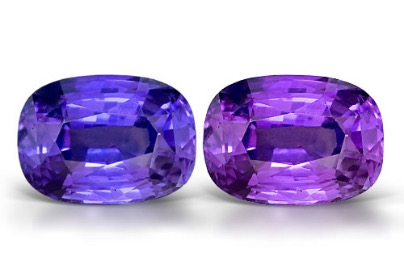Gemstones are precious gifts of the earth that enchant us with the way they look with their varied colors. But there is a certain group of precious stones that don’t conform to one particular look or color. These mystifying beauties are color-changing gemstones and are among the rarest and prettiest of gemstones rightly deserving that place.
A gemstone’s clarity, refraction, color, tone and saturation depend on the way light is absorbed, reflected and refracted by the structure of the gem crystal. A sapphire appears blue because it absorbs the wavelengths of other colors in the light that falls on it except the wavelength corresponding to the blue color. A color-changing gemstone would expel different wavelengths when exposed to different sources and intensities of light, hence the different colors. There are three main types of light sources namely;
- Daylight - Natural sunlight in the daytime
- Incandescent light - Natural indirect light with low intensity (Flames, lights indoors)
- Fluorescent light - Artificial light
Color change of a gemstone differs with the above-differentiated light sources and could be the most sought-after sapphires, garnets or even diamonds that are known as Chameleon diamonds. Let us look into these mystical varieties of precious stones in detail.
- Sapphire - The king of corundum gems, the sapphire also is the family name of a gem variety that changes color. Although sapphires can come in a wide range of colors, color-changing sapphires mostly change from bluish hues to purples or violets - subtle changes, and extraordinary. Natural color-changing sapphires from pristine sources like Sri Lanka are stupendously rare and beautiful, so much so that usually top-tier gem collectors and museums are the ones after them. Natural color-changing sapphires are only available with a select few gemologists such as Hussain and Sons and cost around five times the price of a fixed-colored natural sapphire of the same size. These are rare and should not be mistaken for bi-color sapphires that manifest two distinct colors as a result of color zoning.
- Alexandrite - Named after Tsar Alexander II of Russia, this is a type of Chrysoberyl, meaning that it is a gem structured of beryllium aluminate with a hardness of 8.5 according to the Mohs scale. This splendid gem when first discovered was mistaken for an emerald because it was green in daylight. But at night it turned red, and lately with the advent of artificial light showed a bluish-purple color! Alexandrites with fine and clear color changes are extremely rare and rival the most precious sapphires and diamonds in price. These gemstones are found in Sri Lanka, Russia and Brazil. The best Alexandrites are known to change from green to red in colors as clear as traffic lights!
- Diamond - Some diamonds - fondly and aptly called Chameleon Diamonds, change color depending on whether they are heated, kept in the dark or under a strong light. But, unlike any of the other entries here, the color change of chameleon diamonds is temporary. In low or strong light, they may turn darker or lighter in color. And again, unlike other color-changing gemstones, there is no discernible reason to be observed for this color change. The reasons and the durations of a diamond’s color change are mysterious. This fact and the extreme rarity of these diamonds, make them incredibly valuable.
- Garnet - Garnets are a type of silicate gems, ranging from 6.5 - 7.5 on the Mohs scale in terms of hardness. They are found in almost every color but blue garnets are extremely rare. Color-change garnets, a member of this garnet family are often mistaken to be Alexandrites and sport a brownish-green color or a deep red in natural light and change to a purplish-pink under artificial light. Garnets can be sourced from Madagascar, Norway, Tanzania, the USA, Russia and of course, Sri Lanka.
- Andesine - Named after the famous Andes mountain range, Andesines are also a type of silicate gem, within the feldspar family of minerals. They change colors from hard green to bright purple and are found in Mongolia and Tibet as well. Andesines are present in a variety of colors such as white, grey, green, yellow and red.
- Fluorite - Also called Fluorspar, Color-changing fluorites transition from greenish blue to purple. Fluorites are rather affordable compared to their color-changing gem counterparts and are best suited for pendants, earrings and bracelets that go through minimal wear and tear because they naturally have a lower index in the Moh scale and are rather soft.
- Diaspore - This is an aluminum oxide hydroxide structured gem, making it a closer relative of sapphires and rubies. Diaspores are usually found in white, grey and translucent pearly hues, and are rather easy to procure. However, color-change diaspores, named Zultanite, otherwise called Turkish Diaspores, change from green to pink or green to yellowish-orange and are extremely rare, only being mined at Anatolian Mountains of Turkey.
So next time you shop for a gemstone, make sure to look for more colors in different lights and angles, and you might glimpse a whole another plane of radiant wonder in the jewel in front of you!
